JAPANESE ARMY SEIZES MANCHURIA
Tokyo, Japan • September 18, 1931
The assassination of the Manchurian warlord Zhang Zuolin in June 1928 was the first in a daisy change of major Sino-Japanese crises faced by the new Japanese emperor, Hirohito (posthumously referred to as Emperor Shōwa), whose reign began 18 months before. Manchuria (sometimes referred to by its historical name Guandong) lay directly north of 2 Japanese possessions on the Asian mainland: Korea, since 1905 a Japanese protectorate that was later annexed (1910); and the Kwantung (Guandong) Leased Territory in the southern part of the Liaodong Peninsula, which Japan leased from China for 99 years beginning in 1905. The Japanese Kwantung garrison became the Kwantung Army (see map).In the 1920s Manchuria’s economy alternated between boom and bust under Zhang. The last bust occurred in the winter of 1927–1928 following Zhang’s adventurism in China—Zhang had managed to capture the Chinese capital at Peking (now known as Beijing) in June 1926. In May 1928 Zhang was defeated by Chiang Kai-shek’s Chinese Nationalists. A month later Zhang was killed by a bomb planted by a Japanese Kwantung Army officer as the warlord’s train was en route to the Manchurian city of Mukden (Shenyang in Chinese) over a track operated by Japanese-own South Manchuria Railroad. Militants in the Kwantung Army were furious over Zhang’s failure to halt the advance of the Nationalist army, which at the time was backed by the Soviet Union, then Japan’s strategic rival on the Chinese mainland.
Just over 2 years later, on this date, September 18, 1931, another set of militarist Japanese soldiers planted a bomb, again near Mukden, on a tiny section of the same South Manchuria Railroad, set to detonate when a Japanese train passed close by. Local elements of the Imperial Japanese Army (IJA), tasked with guarding the railway, accused the nearby Chinese garrison under Zhang Zuolin’s son of an unprovoked attack and responded by occupying Mukden on September 19 at a cost of 500 Chinese and 2 Japanese lives. This incursion, known variously as the Mukden or Manchurian Incident, was intended to legitimize the IJA’s response of protecting a vital transportation, commercial, and industrial hub in China’s northeast. Kwantung Army headquarters and troops were moved out of the Leased Territory to Mukden to enhance security.
At the same time an IJA division stationed in Korea made an incursion into Manchuria. Initiated by local commanders, both the Kwantung Army and IJA incursions presented the central government in Tokyo with a dilemma. The Japanese cabinet reluctantly accepted the army’s fait accompli and appropriated funds to send in reinforcements from Japan. Emperor Hirohito, as commander in chief of Japan’s armed forces (daigensui), let slip the opportunity to question the cabinet’s decision, possibly forestall the army’s further independent, insubordinate, and violent expansionist actions (he was personally opposed to them), and bring the mainland armies under Tokyo’s tight grip. Telling the Army General Staff in Tokyo to “be more careful in the future,” Hirohito embarked on a series of imperial retreats in the face of the army’s determination to solidify its influence over foreign affairs and domestic politics as well as by his fear of internal instability and military coup. By 1937, the start of the Sino-Japanese War (1937–1945), the military establishment was aggressively running the whole show without serious criticism or intrusion from the emperor or anyone else.
Manchukuo: Springboard for Further Japanese Expansion in China and Southeast Asia
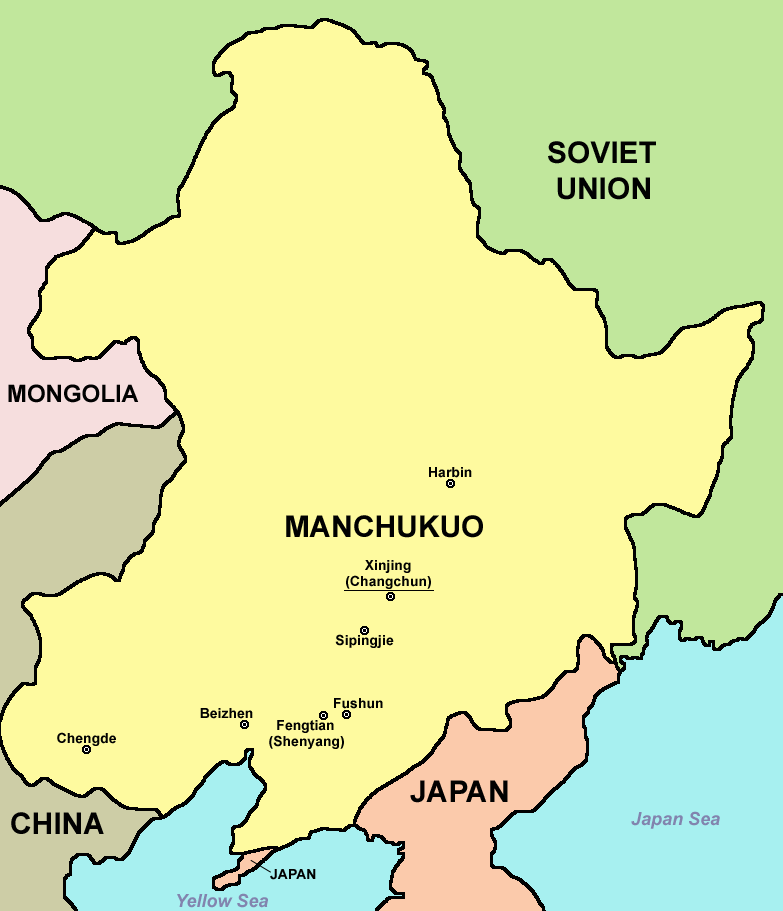
Above: Manchukuo (1931–1945) and its neighbors. A portion of the Liaodong Peninsula and the Korean Peninsula, labeled “Japan” on this map, had been Japanese possessions since 1905 and 1910, respectively. The Mukden Incident (September 18, 1931), which gave the Kwantung Army the pretext to create the Manchukuo state (March 1, 1932), took place near present-day Shenyang, as it appears on the map. During the Manchukuo era Shenyang was called Fengtian in Chinese and Mukden in both English and Manchu. A key railway junction and regional capital, Shenyang developed into a center of heavy industry during the Japanese occupation.
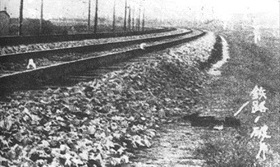 | 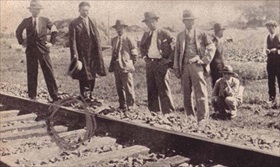 |
Left: Section of the supposedly damaged South Manchuria Railway tracks near the old walled city of Mukden (now Shenyang, capital and largest city of Liaoning Province, as well as the largest city in Northeastern China). The Japanese caption on the right reads, “Railway Fragment.” The nighttime “sabotage” was planned by rogue junior officers in the Japanese Kwantung (Guandong) Army, which was garrisoned in Manchuria to protect Japanese-leased territories and properties along the South Manchuria Railway and in the southern part of the Liaodong Peninsula. Properties owned by the railway company included mines, schools, hospitals, repair depots, and factories.
![]()
Right: A photo published in the jingoistic Japanese newspaper Rekishi Syashin shows several purported Japanese experts inspecting the scene of the Chinese “railway sabotage” on a small, 5‑ft/1.5‑m section (circled) of the main track of the South Manchurian Railway in September 1931. Most Westerners at the time believed the Mukden Incident, though coming on top of other Sino-Japanese “incidents,” was way overblown and should not have led to Japan’s takeover of Manchuria. (The Japanese used the term “incident” as diplomatic cover to avoid an official declaration of war.) Japanese publicists were quick to point out to their American audience how provocations in the U.S.’s Caribbean backyard had brought swift intervention by U.S. Marines.
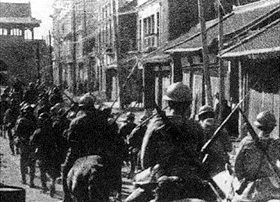 | 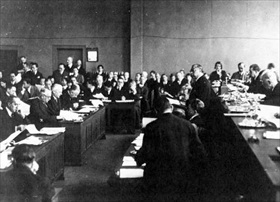 |
Left: Japanese cavalry entering Mukden (Shenyang), Manchuria, September 19, 1931, after claiming that the explosion on South Manchuria Railway tracks was the action of terrorists protesting growing Japanese influence and presence in the area. That same month Japan’s Kwantung Army began a military incursion in Northeast China (time to “cut the Chinese melon,” in the words of some army staff) and by December 1931 it occupied a large part of Manchuria.
![]()
Right: A Chinese delegate addresses the League of Nations after the 1931 Mukden Incident. The Chinese Foreign Ministry issued a strong protest to the Japanese government and called for an immediate halt to Japanese military operations in Manchuria. On September 19, 1931, China appealed to the League of Nations headquarters in Switzerland. A month later, on October 24, the Council of the League of Nations voted to demand the immediate withdrawal of Japanese and Chinese troops from contested areas in Manchuria, to be completed by mid-November. Japan, however, rejected the League’s resolution. In March 1932, following February elections that gave the Japanese government a mandate for its aggressive expansion in China, Tokyo announced the establishment of the puppet state of Manchukuo headed by the last Emperor of China, Henry Pu Yi. Japan withdrew from the League of Nations in 1933, an act Hirohito personally regretted.
Japanese Aggression in Manchuria and China, 1931–1945
![]()

 History buffs, there is good news! The Daily Chronicles of World War II is now available as an ebook for $4.99 on Amazon.com. Containing a year’s worth of dated entries from this website, the ebook brings the story of this tumultuous era to life in a compelling, authoritative, and succinct manner. Featuring inventive navigation aids, the ebook enables readers to instantly move forward or backward by month and date to different dated entries. Simple and elegant! Click
History buffs, there is good news! The Daily Chronicles of World War II is now available as an ebook for $4.99 on Amazon.com. Containing a year’s worth of dated entries from this website, the ebook brings the story of this tumultuous era to life in a compelling, authoritative, and succinct manner. Featuring inventive navigation aids, the ebook enables readers to instantly move forward or backward by month and date to different dated entries. Simple and elegant! Click 











